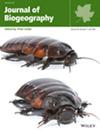Vegetation Structural Complexity Across Elevational Gradients: Insights From the Tropical Andes
Abstract
Aim
Assessing how vegetation volume, fill, and complexity covary along elevation gradients is crucial for understanding the spatial distribution of animal diversity, a key question in biogeography and ecology. Across ecosystems, canopy height sets a limit to vegetation volume, which, combined with vegetation fill, should determine the amount of structures and resources available to animal populations; the structural complexity of the vegetation should, in turn, promote niche differentiation. To facilitate future animal diversity studies, we address how these structural variables covary with each other across an elevation gradient in a biodiversity hotspot where climate and ecosystem productivity are well characterised.
Location
3800 m elevation gradient on the Eastern slopes of the tropical Andes.
Time Period
Present day.
Major Taxa Studied
Terrestrial plants.
Methods
We used land surveys and digital photographs to assess the structure and complexity of the vegetation along the 3800 m gradient, quantifying complexity using information theory metrics.
Results
Whereas canopy height decreased with elevation, the density of the vegetation inside the forest increased monotonically as elevation increased, causing the amount of vegetation structures to peak at mid-elevations. The mid-elevation peak was greatest when the vegetation growing over trees, mainly epiphytes, was considered. With few exceptions, measures of vegetation structural complexity in the forest interior, including the diversity of plant life forms, vertical stratification, and patterns in digital photographs at the stand and microhabitat levels, peaked at intermediate elevations coinciding with ecosystem productivity patterns.
Main Conclusions
We show that the amount of vegetation substrate and its structural complexity peak at intermediate elevations in this region of the Andes, coinciding with peaks in ecosystem productivity and cloud forest conditions. Given the monotonic decrease in temperature with elevation, our data provide an opportunity to assess the relative importance of vegetation structure and climate in shaping biodiversity along mountain slopes and other ecosystems.


 求助内容:
求助内容: 应助结果提醒方式:
应助结果提醒方式:


